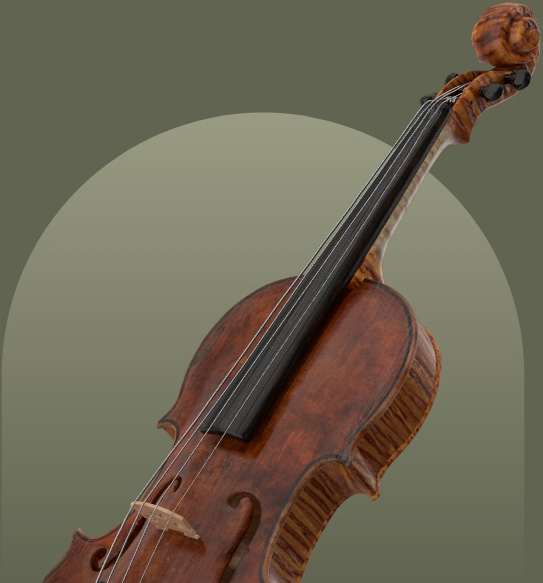John Dilworth
STRADIVARI, (Giovanni) Francesco. Born 1671, died 1743 Cremona Italy. Eldest son of Antonio Stradivari, above. Presumably apprenticed to his father from c.1685 and his chosen successor to judge from Antonio’s will. His workmanship is difficult to distinguish from that of his father, but several distinct soundholes settings can be detected on instruments from the ‘golden period’ and beyond. His handwriting has been tentatively identified on some of the later Stradivari paper patterns stored in the Museo Stradivariano (including details of the ‘Picola B’ cello), so it may be assumed that he achieved some independence within the workshop. Some instruments are known to bear the label (or signs of a label) stating ‘sotto la Disciplina d’Antonio Stradiuari’ but these are rare. The most reliable example of his work is the very fine ‘ex-Salabue’ violin of 1742. Its most striking aspects are the sloping, widely disposed soundholes with narrow wings, a slightly cramped and crudely finished terminus to the volutes of the scroll, and rather mis-managed purfling mitres. The varnish is rich and fully up to the best work of Antonio but the materials are decidedly plain. It is worth noting that Francesco himself was already 71 when the instrument was made and he died the following year having outlived his father by only six years. Francesco Stradivarius Cremonensis / Filius Antonii faciebat Anno 1742 Franciscus Stradivarius sub disciplina / A. Stradivarii 1700 [Rosengard & Chiesa]
Cecie Stainer
Son of Antonio Stradivari; b Feb. 1, 1671, Cremona; d. May 11, 1743. Was a pupil of his father and worked in his workshop until Antonio’s death; he then continued to work with his brother Omobono. He made several violins and violas, in which he placed his own label, from about 1725 to 1740; his work shows the excellent school in which he had been trained, and has genuine merit, but is much inferior to that of his father. The varnish is very beautiful, though quite different from that of Antonio, it is of brownish hue; the scroll is heavy, the work not very carefully finished, but the tone rich and penetrating. Label : ” Franciscus Stradivarius Cremonensis filius Antonii faciebat, anno 1742.”
George Hart
Son of Antonio Stradivari. Worked with his brother Omobono for several years. Many of the later works of Antonio Stradivari have been attributed to his sons. The character of the work is wholly distinct. I can well understand the error of attributing the instruments of Francesco Stradivari to Carlo Bergonzi, there being many points in common, but that so many marked specimens of the works of Antonio should be deemed apocryphal is beyond my comprehension. The work of Francesco is altogether less finished, but at the same time it shows the hand of the master. The design is bold and original. The sound-hole is quite unlike that of Antonio. The tone of Francesco’s instruments is invariably very rich and telling. Lancetti states—speaking of Francesco Stradivari—”After the death of his father, he made several Violins and Tenors, to which he put his own name. Although he did not succeed in perfectly imitating the works of his father, the instruments which he made in the years 1740 and 1742, and which remained after his death in the possession of his brother Paolo, were sold at the same price as those of his father, as mentioned in the correspondence between Count Cozio and Paolo. Francesco died at the end of 1742, the year Omobono died, and in which he made the Violins bought by Count Cozio.” The date of death as given by Lancetti, though incorrect by some months, he having died May nth, 1743, aged 72 years, shows the care and trouble taken to render the information as complete as possible, these dates having been given without reference to registers, but simply as stated by Paolo.
Willibald Leo Lütgendorff
Sohn und Schüler von Antonio Stradivari. Nach dem Tode seines Vaters arbeitete er eine Zeit lang mit seinem Bruder Omobono zusammen. Zettel mit seinem Namen klebte er in seine Arbeiten erst nach dem Tode seines Vaters ein. Seine Geigen haben noch das Gepräge des Stradivari’schen Geistes und sind herrlich im Ton, aber bei Weitem weniger sorgfältig ausgeführt als die seines Vaters, den er so wenig erreichte, als er seinen besseren Mitschüler gleichkam. Der Lack ist bräunlich-orangegelb und die Schnecke recht hübsch. Eine Geige von ihm aus dem Jahre 1735 besitzt Karl Prill in Leipzig.
Henri Poidras
Son of Antonio Stradivarius. Make of great value which is however not equal to that of his father, the workmanship, design and cut of the sound holes being inferior. The exceptional tone qualities of his instruments are their best recommendation. Dark orange-yellow varnish. His scrolls are admirably carved.
Karel Jalovec
Cremona, Born Feb. 1, 1671, died May 11, 1743. Son and pupil of Antonio Stradivari. After his father’s death he continued to run the shop in company with his brother Omobono. His works are imitations of the large violin model of his father in 1708; they have a very good, powerful tone, though lacking the careful finish of instruments built by his father. Violins by Francesco have broad edges, their purfling is not so handsome, the sound-holes are upright, rather open after the Amati brothers’ fashion and the right sound-hole is in a more inclined position. He applied orange-yellow varnish, which is of fairly good quality, but falls short of that used by Antonio. The scrolls of his instruments are beautifully carved. Even without Antonio, Francesco would have become very famous. Price 160.000 Kc; some of his instruments fetched, however, as much as 320.000 Kc.
